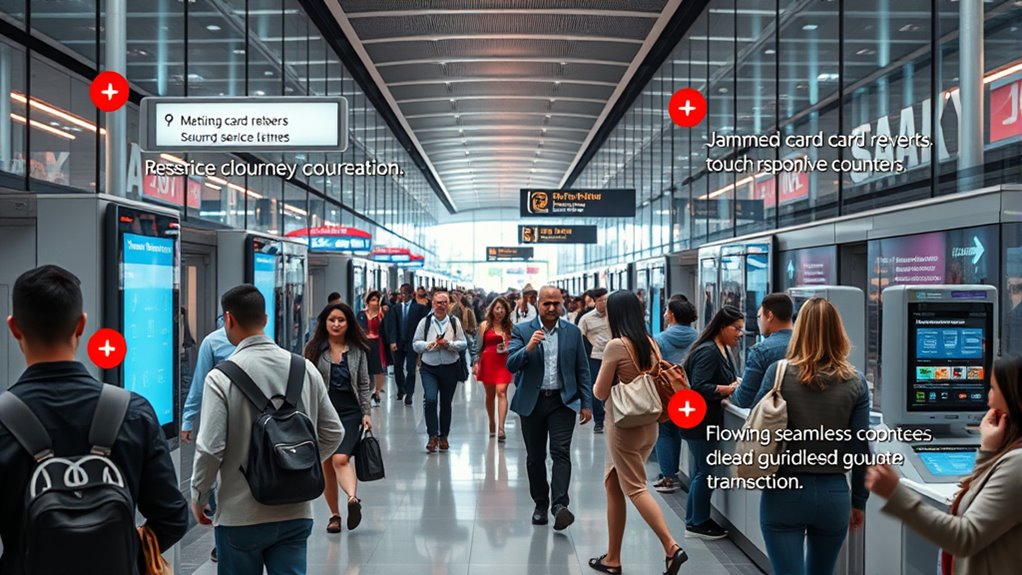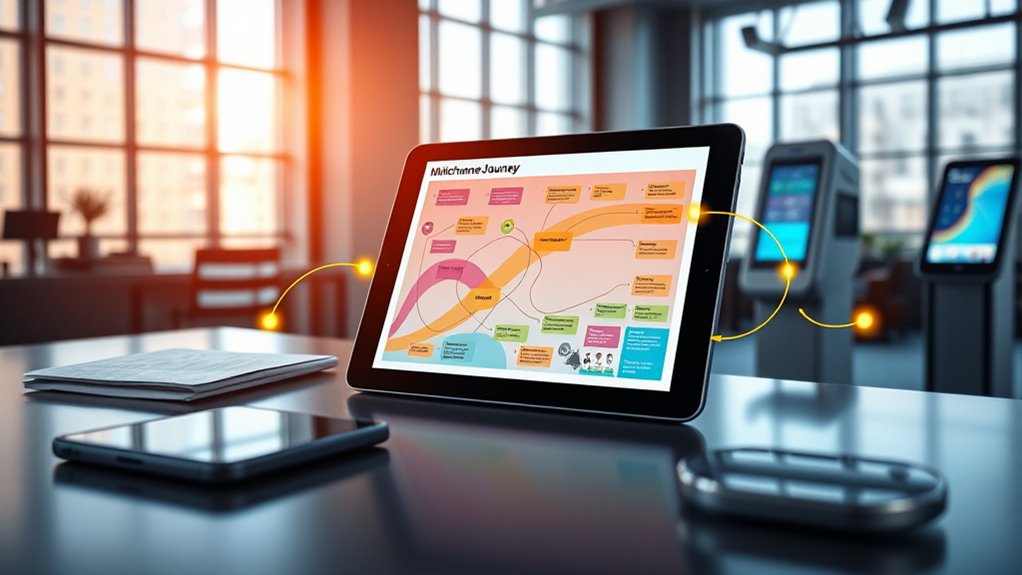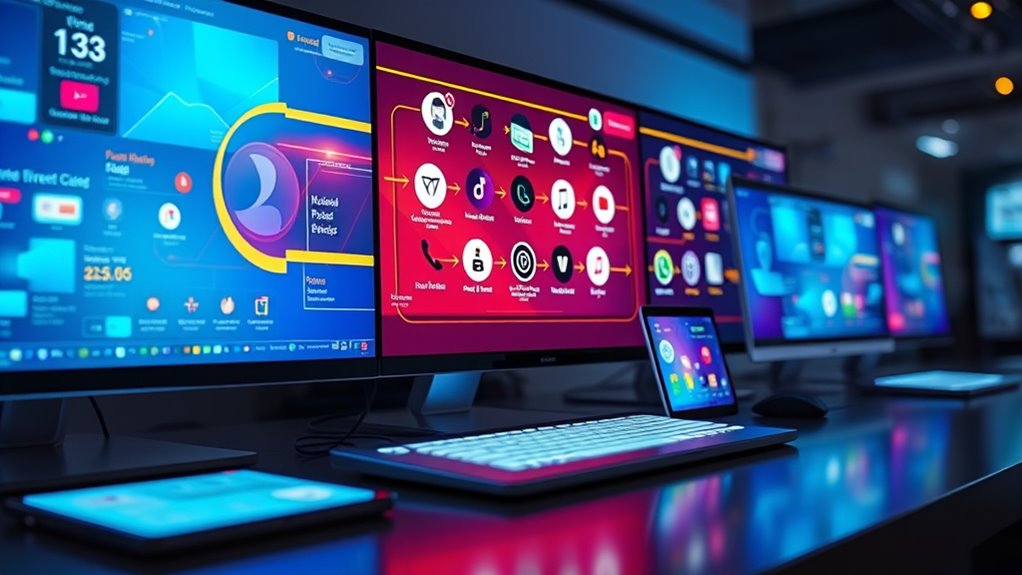To transform friction into flow in your multichannel journey, start by understanding your customers’ emotional and cultural expectations at each touchpoint. Eliminate pain points through user insights, ensuring consistency in visuals, messaging, and interactions across channels. Use cues and seamless progressions to guide users naturally, and incorporate feedback loops for ongoing improvement. Align organizational processes to maintain cohesive experiences, so your service feels effortless and connected—exploring these strategies further can help you craft truly seamless customer journeys.
Key Takeaways
- Identify and address touchpoint gaps and inconsistencies through mapping the entire customer journey for seamless experience.
- Ensure visual and messaging consistency across channels using unified branding, tone, and design elements.
- Simplify transitions between channels with clear cues, reducing cognitive load and enhancing emotional connection.
- Leverage personalization and cultural insights to tailor interactions, fostering trust and relevance.
- Use continuous feedback and real-time data to iteratively refine touchpoints, minimizing friction and optimizing flow.
Understanding Customer Expectations Across Channels

To effectively design multichannel journeys, you need to understand customer expectations across different touchpoints. Emotional expectations play a vital role, as customers seek not just functional solutions but also positive feelings during interactions. Recognize that these expectations vary widely based on cultural influences, which shape how customers perceive service quality and communication styles. For example, some cultures value formal, respectful exchanges, while others prioritize familiarity and friendliness. By acknowledging these differences, you can tailor your touchpoints to foster trust and satisfaction. Understanding what customers seek emotionally helps you create consistent, meaningful experiences across channels. Additionally, having a reliable bike maintenance routine can enhance customer confidence in your service offerings. Ultimately, aligning your service design with diverse emotional and cultural expectations ensures a seamless journey that resonates with all customer segments.
Identifying and Eliminating Common Friction Points

To improve your multichannel experience, start by pinpointing pain points that disrupt customer flow. Next, analyze touchpoint gaps to identify where passageways feel disjointed or confusing. Finally, streamline these shift phases to create smoother, frictionless journeys across all channels. Incorporating organized zones within the customer journey can help clarify pathways and reduce confusion, ensuring a more seamless experience.
Pinpointing Pain Points
Identifying pain points is essential for creating seamless multichannel journeys, as friction points can considerably hinder user satisfaction and conversion rates. To do this effectively, focus on emotional triggers that influence user behavior; these can reveal underlying frustrations or anxieties. Pay close attention to cultural sensitivities, as what feels intuitive in one context may cause discomfort or misunderstanding in another. Observing user interactions across channels helps you spot recurring issues, whether technical glitches or confusing navigation. Gathering direct feedback through surveys or interviews uncovers hidden pain points rooted in emotional responses or cultural nuances. Incorporating natural elements into the design can help foster a more calming and welcoming environment. Pinpointing these friction points allows you to address core problems, improving the overall experience and ensuring your service resonates positively across diverse audiences.
Analyzing Touchpoint Gaps
Once you’ve pinpointed individual pain points, examining the touchpoints where users interact with your service helps uncover broader friction patterns. Look for gaps where the experience feels disjointed or confusing, especially across channels. Use personalization strategies to tailor interactions and identify inconsistencies that disrupt flow. Technological integration plays a key role here—by connecting systems seamlessly, you can reveal where data or process breakdowns occur. Map out the entire journey to spot recurring issues or friction points that cause frustration. Addressing these gaps requires not just fixing isolated problems but understanding how different touchpoints influence each other. For example, contrast ratio differences across devices can impact perceived image quality and user satisfaction. By systematically analyzing these gaps, you can eliminate common friction points, creating a smoother, more cohesive multichannel experience for your users.
Streamlining Transition Phases
Streamlining shift phases is essential for creating a seamless multichannel experience, as users often encounter friction when moving between touchpoints. To do this effectively, identify common pain points that disrupt emotional resonance or cultural relevance. For example, inconsistent messaging or confusing navigation can break the connection users feel with your brand. Simplify transition steps, ensuring they feel natural and aligned with users’ expectations. Use clear cues and familiar cues that resonate emotionally and culturally, reducing cognitive load. Additionally, understanding the Relationships – Personality Test can help tailor communication styles to enhance user engagement during transitions. By eliminating friction points during these shifts, you foster trust and engagement. Remember, every smooth transition reinforces your brand’s relevance and emotional connection, making the overall journey feel effortless and personalized. This approach transforms friction into flow, encouraging continued interaction across channels.
Designing Consistent and Coherent Touchpoints

You need to guarantee your touchpoints feel unified across channels, so users recognize your brand easily. Consistent visual identity and seamless interaction flow help build trust and reduce confusion. By aligning these elements, you create a smoother, more coherent journey for your customers. Incorporating auditory cues can further enhance recognition and engagement across diverse platforms.
Uniform Visual Identity
How can you guarantee that every touchpoint across channels feels familiar and trustworthy? The key is establishing a uniform visual identity. Consistent use of your brand recognition elements, like your logo and messaging, helps customers feel assured. A well-defined color palette plays a vital role, reinforcing your brand’s personality and making touchpoints instantly recognizable. Avoid mixing styles or changing visual elements across platforms, as inconsistency can create confusion and diminish trust. Instead, develop clear guidelines for colors, fonts, and imagery, and ensure every team member adheres to them. This coherence assures customers they’re engaging with the same brand, regardless of the channel. Implementing color consistency across all touchpoints is essential for reinforcing brand recognition and trust. Ultimately, a unified visual identity strengthens brand loyalty and creates a seamless experience that feels trustworthy and professional.
Seamless Interaction Flow
A consistent visual identity sets the foundation for trust, but creating a truly seamless experience requires designing interaction flows that connect touchpoints smoothly. You should focus on ensuring that each interaction feels coherent, guiding users effortlessly through their journey. Incorporate personalization strategies to deepen emotional engagement, making each touchpoint feel tailored to individual needs. Use familiar cues and predictable patterns to reduce cognitive load, so users stay confident and comfortable. When transitions between channels are fluid, customers experience less frustration and build stronger connections with your brand. By aligning messaging, tone, and interface elements across all touchpoints, you create a cohesive flow that fosters loyalty and satisfaction. Understanding the interpretation of prophetic dreams can inspire designers to recognize symbols and patterns that resonate universally, enhancing user comprehension and emotional connection. Ultimately, a seamless interaction flow transforms multi-channel complexity into a unified, engaging customer experience.
Leveraging Visual and Interaction Cues for Guidance

Leveraging visual and interaction cues is essential for guiding users seamlessly across multichannel journeys. Gesture cues help users understand how to interact naturally, whether swiping, tapping, or dragging, reducing confusion and encouraging fluid movement. Color coding, on the other hand, offers immediate visual clarity, signaling different statuses, categories, or actions at a glance. Consistent use of these cues across channels creates a cohesive experience, reinforcing user expectations and minimizing friction. When gesture cues are intuitive and aligned with common behaviors, users navigate confidently. Similarly, thoughtful color schemes direct attention and communicate progress or alerts efficiently. By strategically applying these visual and interaction cues, you enable users to move effortlessly through their journey, fostering trust and satisfaction at every touchpoint. Additionally, incorporating design heuristics rooted in familiar patterns ensures that users can quickly adapt to new interfaces, enhancing overall usability.
Incorporating Feedback Loops for Continuous Improvement

Building on the importance of visual and interaction cues, incorporating feedback loops into your multichannel journey guarantees continuous refinement and better user experiences. Feedback integration allows you to gather real-time insights directly from users, helping you identify pain points or areas for improvement. By establishing clear channels for collecting feedback, you enable ongoing dialogue that fuels iterative refinement of your service. This approach ensures that adjustments are data-driven and responsive to user needs. Regularly analyzing feedback helps you fine-tune touchpoints, reduce friction, and enhance overall flow. Implementing effective feedback loops transforms your service into a dynamic system, continuously evolving based on user input. Leveraging predictive analytics can further optimize your feedback processes by anticipating user needs and preferences. This ongoing cycle of feedback and refinement ultimately creates a more seamless, user-centered multichannel experience.
Aligning Organizational Processes for Seamless Transitions

To guarantee a smooth multichannel journey, you must align organizational processes across departments and touchpoints. Cross-department collaboration ensures that everyone shares a common understanding and works toward seamless transitions. When teams communicate effectively and coordinate their efforts, it reduces friction and creates a unified customer experience. Building organizational agility allows your company to adapt quickly to changing customer needs and technology shifts. This flexibility helps you identify and resolve bottlenecks before they impact the customer. Standardizing procedures and establishing clear workflows across departments foster consistency. Regularly reviewing and updating processes keeps your organization responsive and aligned. Ultimately, aligning internal processes minimizes gaps, enhances coordination, and ensures customers experience smooth, cohesive interactions regardless of the channel they choose.
Frequently Asked Questions
How Can Service Design Heuristics Adapt to Emerging Digital Trends?
You can adapt service design heuristics to emerging digital trends by embracing AI integration to streamline processes and improve responsiveness. Personalization strategies become more effective when tailored to user behaviors across channels, creating seamless experiences. By continuously updating heuristics to include new technologies, you guarantee your service stays relevant, engaging users on their preferred platforms. This proactive approach helps you turn digital innovations into meaningful, user-centric improvements.
What Role Does Employee Training Play in Seamless Multichannel Experiences?
You play a vital role in creating seamless multichannel experiences by focusing on employee engagement and skill development. When you’re well-trained, you can adapt quickly across channels, providing consistent and effective service. Investing in ongoing training boosts your confidence and knowledge, ensuring you understand customer needs regardless of the platform. Your engagement directly impacts the customer journey, making it smoother and more cohesive, ultimately fostering trust and loyalty.
How Can Organizations Measure Success in Multichannel Journey Improvements?
Ever wondered how you can tell if your multichannel improvements work? You can measure success by tracking customer satisfaction scores and analyzing feedback across channels. Are your KPIs aligned with your customer experience goals? When these metrics show positive trends, it indicates your efforts are effective. Regularly reviewing these indicators helps you verify your journey enhancements genuinely meet customer needs and deliver consistent, seamless experiences.
What Are Effective Methods for Prioritizing Touchpoint Enhancements?
You should focus on prioritizing touchpoint enhancements by analyzing customer feedback to identify pain points and high-impact areas. Use this input to guide resource allocation, making sure efforts target the most critical moments in the journey. By aligning improvements with customer needs and feedback, you’ll maximize value and create seamless experiences. Regularly review feedback and adjust priorities to guarantee your enhancements continue to meet evolving customer expectations effectively.
How Do Cultural Differences Impact Multichannel Service Design Strategies?
You should recognize that cultural differences considerably influence how customers engage across channels. By prioritizing cultural sensitivity, you guarantee your service resonates broadly. Implement localization strategies that adapt content, language, and visuals to fit diverse audiences, creating seamless experiences. This approach helps you build trust and loyalty, as customers feel understood and valued. Ultimately, embracing cultural nuances enables you to design more effective, inclusive multichannel strategies that meet varied customer expectations.
Conclusion
By mastering these heuristics, you’ll turn chaotic multichannel journeys into smooth, effortless experiences—almost like magic. When you understand customer expectations, eliminate friction, and create seamless touchpoints, you’ll build loyalty that’s almost superhuman. Keep refining with feedback loops and align your organization’s processes, and you’ll transform your service design into an unstoppable force. Remember, a well-crafted journey isn’t just good; it’s the secret weapon to dominating your market!









